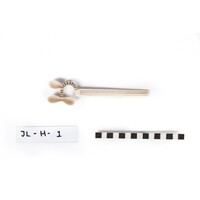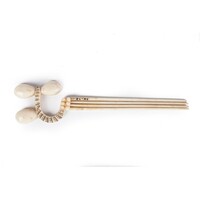Scope and Content
[Source - Nessa Leibhammer for FHYA, 2015, using Brenthurst materials and JAG records: Snuff-spoon]
Metadata
Snuff-spoon
[ Source of title : Nessa Leibhammer using JAG materials ]
Object
JL-H-1
Creative Commons License: CC BY-NC-ND https://creativecommons.org/licenses/by-nc-nd/4.0/
Additional information [Source - Sarah Schaefer for FHYA, 2020, transcription of the Brenthurst catalogue, 'Art and Ambiguity: Perspectives on the Brenthurst Collection of Southern African Art', produced by the Johannesburg Art Gallery, 1991: Snuff-spoon; bone, pigment; 17,4 x 4,1 x 0,6; North Nguni; JL·H-1; (Fig. 114)]
Attributions and conjectures [Source - Nessa Leibhammer for FHYA, 2017: Comments on classification: In his 'A Preliminary Survey of the Bantu Tribes of South Africa', Union of South Africa, Department of Native Affairs, Ethnological Publications, Vol. 5, Pretoria, Government Printer, (1935): 7, 70-83, national government ethnologist, Nicholas Van Warmelo did not use the term "North Nguni". He grouped people living both north and south of the Thukela, under one umbrella term, "Natal Nguni", based on linguistic affinity. His classification was adapted by the ethnology curator, Margaret Shaw, in her 1958 "System of Cataloguing Ethnographic Material in Museums" which determined that items from the region were to be classified as "Natal Nguni: Zulu and others (not differentiated)." According to art historian, Anitra Nettleton, the classificatory system used by art galleries and museum shifted from Shaw's model to the one where "Natal Nguni" fell away and was replaced by "North/Northern Nguni" for KwaZulu-Natal and Swaziland because scholars found it difficult to distinguish items from adjacent areas, or emmigrant people from those from the KZN region. Scholars working with the JAG materials used broad ethno-linguistic categories (Zulu, Xhosa, Tsonga, Shona, Sotho, Tswana) to identify the makers/users of the objects, all of which came to JAG without much by way of provenance, and identification was based on factors such as object type, materials, formal composition, style and surface patterning (emails A. Nettleton to N. Leibhammer, 25 and 28 November 2014). Jonathan Lowen employed Margaret Carey, a British ethnologist, to catalogue his collection collection in the winter of 1983-84. She classified many of the objects as 'Zulu' (sic) simply because of a lack of information about the objects. (Rhoda Rosen citing Sandra Klopper.) For an extended version of this note on JAG classification see: 'JAG Classification Note' in Additional Resources]
| Event Actor | Event Type | Event Date | Event Description |
|---|---|---|---|
| Five Hundred Year Archive (FHYA) | Online curation | 2016 - | Digital image by Nessa Leibhammer |
| Johannesburg Art Gallery (JAG) | Custody | 1987 - | |
| Oppenheimer Family | Ownership | 1987 | |
| Jonathan Lowen | Collection | [19-?] | |
| No attribution | Making | YYYY |
If you have difficulty accessing the objects, use these links.


Contributions